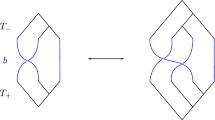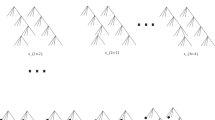Abstract
We give a unified solution to the conjugacy problem for Thompson’s groups \(F, \,T\), and \(V\). The solution uses “strand diagrams”, which are similar in spirit to braids and generalize tree-pair diagrams for elements of Thompson’s groups. Strand diagrams are closely related to piecewise-linear functions for elements of Thompson’s groups, and we use this correspondence to investigate the dynamics of elements of \(F\). Though many of the results in this paper are known, our approach is new, and it yields elegant proofs of several old results.

























Similar content being viewed by others
Notes
A weaker version of the Newman’s Diamond Lemma suffices: see Theorem 1 in [18].
References
Belk, J.M.: Thompson’s Group \(F\). PhD thesis, Cornell University, (2004). arXiv:math.GR/0708.3609v1
Bleak, C., Bowman, H., Gordon, A., Graham, G., Hughes, J., Matucci, F., Sapir, E.: Centralizers in R. Thompson’s group \({V}_n\). Groups Geom. Dyn., to appear. arXiv:math.GR/1107.0672v3
Bogley, W.A., Pride, S.J.: Calculating generators of \(\Pi _2\). In: Two-dimensional homotopy and combinatorial group theory, volume 197 of London Math. Soc. Lecture Note Ser., pp. 157–188. Cambridge Univ. Press, Cambridge (1993)
Brin, M.G., Squier, C.C.: Presentations, conjugacy, roots, and centralizers in groups of piecewise linear homeomorphisms of the real line. Comm. Algebra 29(10), 4557–4596 (2001)
Brin, M.G.: The algebra of strand splitting. I. A braided version of Thompson’s group \(V\). J. Group Theory 10(6), 757–788 (2007)
Brown, K.S.: Finiteness properties of groups. In: Proceedings of the Northwestern Conference on Cohomology of Groups (Evanston, Ill., 1985), volume 44, pp 45–75 (1987)
Cannon, J.W., Floyd, W.J., Parry, W.R.: Introductory notes on Richard Thompson’s groups. Enseign. Math. (2) 42(3–4), 215–256 (1996)
Gill, N., Short, I.: Conjugacy, roots, and centralizers. In: Thompson’s group \(F\). Proc. Am. Math. Soc., to appear. arXiv:math.GR/0709.1987v2
Guba, V.S., Sapir, M.V.: Diagram groups. Mem. Amer. Math. Soc. 130(620), viii+117 (1997)
Guba, V.S., Sapir, M.V.: On subgroups of the R. Thompson group \(F\) and other diagram groups. Mat. Sb. 190(8), 3–60 (1999)
Higman, G.: Finitely presented infinite simple groups. Department of Pure Mathematics, Department of Mathematics, I.A.S. Australian National University, Canberra, 1974. Notes on Pure Mathematics, No. 8 (1974)
Hossain, N.: Implementation of the solution to the conjugacy problem in Thompson’s groups. Undergraduate senior project, Bard College (2013)
Kassabov, M., Matucci, F.: The simultaneous conjugacy problem in groups of piecewise linear functions. Groups Geom. Dyn. 6(2), 279–315 (2012)
Mather, J.N.: Commutators of diffeomorphisms. Comment. Math. Helv. 49, 512–528 (1974)
Matucci, F.: Algorithms and classification in groups of piecewise-linear homeomorphisms. PhD thesis, Cornell University (2008). arXiv:math.GR/0807.2871v1
Matucci, F.: Mather invariants in groups of piecewise-linear homeomorphisms. In: Combinatorial and geometric group theory, Trends Math., pp. 251–260. Birkhäuser/Springer Basel AG, Basel (2010)
Mohar, B., Thomassen, C.: Graphs on Surfaces. Johns Hopkins Studies in the Mathematical Sciences. Johns Hopkins University Press, Baltimore (2001)
Newman, M.H.A.: On theories with a combinatorial definition of “equivalence”. Ann. Math. (2) 43, 223–243 (1942)
Pride, S.J.: Geometric methods in combinatorial semigroup theory. In: Semigroups, Formal Languages and Groups (York, 1993), volume 466 of NATO Adv. Sci. Inst. Ser. C Math. Phys. Sci., pages 215–232. Kluwer Acad. Publ., Dordrecht (1995)
Pride, S.J.: Low-dimensional homotopy theory for monoids. Intern. J. Algebra Comput. 5(6), 631–649 (1995)
Salazar-Díaz, O.: Thompson’s group \(V\) from the dynamical viewpoint. PhD thesis, State University of New York at Binghamton (2006)
Acknowledgments
The authors would like to thank Ken Brown and Martin Kassabov for a very careful reading of this paper and many helpful remarks. The authors would also like to thank Stephen Pride for providing fundamental references and Collin Bleak, Matt Brin, Jörg Lehnert and Mark Sapir for helpful conversations. Finally, the authors would like to thank the referee for many helpful comments and suggestions. The first author gratefully acknowledges partial support from an NSF Postdoctoral Research Fellowship while he was at Texas A&M University. The second author gratefully acknowledges the Centre de Recerca Matemàtica (CRM) and its staff for the support received during the development of this work.
Author information
Authors and Affiliations
Corresponding author
Additional information
This work is part of the second author’s Ph.D. thesis at Cornell University.
Rights and permissions
About this article
Cite this article
Belk, J., Matucci, F. Conjugacy and dynamics in Thompson’s groups. Geom Dedicata 169, 239–261 (2014). https://doi.org/10.1007/s10711-013-9853-2
Received:
Accepted:
Published:
Issue Date:
DOI: https://doi.org/10.1007/s10711-013-9853-2




